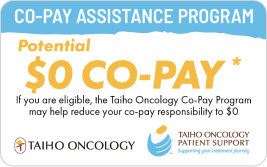Taiho Oncology Patient SupportTM for you and your patients
Meeting the access needs of your patients
Taiho Oncology Patient SupportTM offers personalized services to help give patients, caregivers and healthcare professionals access to Taiho Oncology products. This includes insurance coverage determination and help with medication affordability. For more information, please visit or refer patients to TaihoPatientSupport.com.
Getting patients access to their medicine is an important step. Taiho Oncology Patient SupportTM strives to make this process as simple as possible.

Financial Support
Eligible, commercially insured patients can enroll in the Taiho Oncology Patient SupportTM Co-Pay Program which may help reduce out-of-pocket expenses to $0* for their treatment with LONSURF. To determine patient eligibility, visit taihooncologycopay.com or call 1‑844‑TAIHO‑4U (1‑844‑824‑4648).
Enroll in Co-Pay Program
*Restrictions and eligibility: Offer valid in the US, Puerto Rico, and US territories only. Only valid for patients with private insurance. Offer not valid for prescriptions reimbursed under Medicaid, a Medicare drug benefit plan, Tricare, or other federal or state programs (such as medical assistance programs). If the patient is eligible for drug benefits under any such program, this offer is not valid and the patient cannot use this offer. By presenting or accepting this benefit, patient and pharmacist agree not to submit claim for reimbursement under the above programs. Patient further agrees to comply with any and all terms of his or her health insurance contract requiring notification to his or her payer of the existence and/or value of this offer. It is illegal to or offer to sell, purchase, or trade this benefit. Maximum reimbursement limits apply; patient out-of-pocket expense may vary. Taiho Oncology, Inc., reserves the right to rescind, revoke, or amend this offer at any time without notice.
Insurance Coverage Support
- Benefits investigation
- Prior authorization assistance
- Appeals assistance
- Coordination of prescriptions with pharmacies
Patient Affordability Assistancea
- $0 co-pay program enrollment for eligible commercially insured patients
- Patient assistance program designed to provide free medication to eligible patients who are uninsured or underinsured
- Referrals to third-party foundations for co-pay or other assistance based on eligibility and additional criteria
- Referrals to Medicare Part D Low-Income Subsidy (LIS)/Extra Help Program
Personalized Nurse Supportb
- One-on-one nurse educational support for patients, available via opt-in
aVisit TaihoPatientSupport.com to see full eligibility criteria.
bIf this option is selected on the Patient Enrollment Form, a Nurse Navigator will be assigned to provide telephone support and will address general inquiries about your patient's Taiho Oncology medicine treatment.
How to enroll

Via HCP Portal
- Enroll online, directly through our HCP portal
- NOTE: Login required. Please register prior to enrolling

Download, Print, and Fax
- Download and fill in the Enrollment Form and print it out to complete
- Fax the completed form to 1‑844‑287‑2559
Billing & Coding Information
| Metastatic colorectal cancer | |
| Diagnosis codes for LONSURF use in metastatic colorectal cancer1 | |
| ICD-10-CM | Description |
| C18.0 | Malignant neoplasm of cecum |
| C18.2 | Malignant neoplasm of ascending colon |
| C18.3 | Malignant neoplasm of hepatic flexure |
| C18.4 | Malignant neoplasm of transverse colon |
| C18.5 | Malignant neoplasm of splenic flexure |
| C18.6 | Malignant neoplasm of descending colon |
| C18.7 | Malignant neoplasm of sigmoid colon |
| C18.8 | Malignant neoplasm of overlapping sites of colon |
| C18.9 | Malignant neoplasm of colon, unspecified |
| C19 | Malignant neoplasm of rectosigmoid junction |
| C20 | Malignant neoplasm of rectum |
| C21.8 | Malignant neoplasm of overlapping sites of rectum, anus and anal canal |
| C78.5 | Secondary malignant neoplasm of large intestine and rectum |
| C78.6 | Secondary malignant neoplasm of retroperitoneum and peritoneum |
| D37.4 | Neoplasm of uncertain behavior of colon |
| D37.5 | Neoplasm of uncertain behavior of rectum |
| Metastatic gastric cancer | |
| Diagnosis codes for LONSURF use in metastatic gastric cancer1 | |
| ICD-10-CM | Description |
| C16.0 | Malignant neoplasm of cardia |
| C16.1 | Malignant neoplasm of fundus of stomach |
| C16.2 | Malignant neoplasm of body of stomach |
| C16.3 | Malignant neoplasm of pyloric antrum |
| C16.4 | Malignant neoplasm of pylorus |
| C16.5 | Malignant neoplasm of lesser curvature of stomach, unspecified |
| C16.6 | Malignant neoplasm of greater curvature of stomach, unspecified |
| C16.8 | Malignant neoplasm of overlapping sites of stomach |
| C16.9 | Malignant neoplasm of stomach, unspecified |
This information is not intended as coverage or coding advice and does not guarantee reimbursement. You should verify the appropriate reimbursement information for services or items you provide. Each healthcare professional is responsible for ensuring all coding is accurate and appropriate.
Reference: 1. National Center for Health Statistics. International Classification of Diseases, Tenth Revision, Clinical Modification (ICD‑10‑CM). Centers for Disease Control and Prevention. Accessed December 19, 2023. https://ftp.cdc.gov/pub/Health_Statistics/NCHS/Publications/ICD10CM/2024/
INDICATIONS
LONSURF is indicated as a single agent or in combination with bevacizumab for the treatment of adult patients with metastatic colorectal cancer previously treated with fluoropyrimidine‑, oxaliplatin‑ and irinotecan‑based chemotherapy, an anti‑VEGF biological therapy, and if RAS wild‑type, an anti‑EGFR therapy.
LONSURF is indicated for the treatment of adult patients with metastatic gastric or gastroesophageal junction adenocarcinoma previously treated with at least two prior lines of chemotherapy that included a fluoropyrimidine, a platinum, either a taxane or irinotecan, and if appropriate,


INDICATIONS
LONSURF is indicated as a single agent or in combination with bevacizumab for the treatment of adult patients with metastatic colorectal cancer previously treated with fluoropyrimidine‑, oxaliplatin‑ and irinotecan‑based chemotherapy, an anti‑VEGF biological therapy, and if RAS wild‑type, an anti‑EGFR therapy.
LONSURF is indicated for the treatment of adult patients with metastatic gastric or gastroesophageal junction adenocarcinoma previously treated with at least two prior lines of chemotherapy that included a fluoropyrimidine, a platinum, either a taxane or irinotecan, and if appropriate,
IMPORTANT SAFETY INFORMATION
WARNINGS AND PRECAUTIONS
Severe Myelosuppression: In the 1114 patients who received LONSURF as a single agent, LONSURF caused severe or life‑threatening myelosuppression (Grade 3‑4) consisting of neutropenia (38%), anemia (17%), thrombocytopenia (4%) and febrile neutropenia (3%). Three patients (0.3%) died due to neutropenic infection/sepsis; four other patients (0.5%) died due to septic shock. A total of 14% of patients received granulocyte‑colony stimulating factors. In the 246 patients who received LONSURF in combination with bevacizumab, LONSURF caused severe or life-threatening myelosuppression (Grade 3‑4) consisting of neutropenia (52%), anemia (5%), thrombocytopenia (4%) and febrile neutropenia (0.4%). One patient (0.4%) died due to abdominal sepsis and two other patients (0.8%) died due to septic shock. A total of 29% of patients received granulocyte-colony stimulating factors. Obtain complete blood counts prior to and on Day 15 of each cycle of LONSURF and more frequently as clinically indicated. Withhold LONSURF for severe myelosuppression and resume at the next lower dosage.
Embryo‑Fetal Toxicity: LONSURF can cause fetal harm when administered to a pregnant woman. Advise pregnant women of the potential risk to the fetus. Advise females of reproductive potential to use effective contraception during treatment and for at least 6 months after the final dose.
USE IN SPECIFIC POPULATIONS
Lactation: It is not known whether LONSURF or its metabolites are present in human milk. There are no data to assess the effects of LONSURF or its metabolites on the breastfed child or the effects on milk production. Because of the potential for serious adverse reactions in breastfed children, advise women not to breastfeed during treatment with LONSURF and for 1 day following the final dose.
Male Contraception: Because of the potential for genotoxicity, advise males with female partners of reproductive potential to use condoms during treatment with LONSURF and for at least 3 months after the final dose.
Geriatric Use: Patients 65 years of age or older who received LONSURF as a single agent had a higher incidence of the following hematologic laboratory abnormalities compared to patients younger than 65 years: Grade 3 or 4 neutropenia (46% vs 32%), Grade 3 anemia (20% vs 14%), and Grade 3 or 4 thrombocytopenia (6% vs 3%). Patients 65 years of age or older who received LONSURF in combination with bevacizumab had a higher incidence of the following hematologic laboratory abnormalities compared to patients younger than 65 years: Grade 3 or 4 neutropenia (60% vs 46%) and Grade 3 or 4 thrombocytopenia (5% vs 4%).
Renal Impairment: No adjustment to the starting dosage of LONSURF is recommended in patients with mild or moderate renal impairment (CLcr of 30 to 89 mL/min). Reduce the starting dose of LONSURF for patients with severe renal impairment (CLcr of 15 to 29 mL/min) to a recommended dosage of 20 mg/m2.
Hepatic Impairment: Do not initiate LONSURF in patients with baseline moderate or severe (total bilirubin > 1.5 times ULN and any AST) hepatic impairment. Patients with severe hepatic impairment (total bilirubin > 3 times ULN and any AST) were not studied. No adjustment to the starting dosage of LONSURF is recommended for patients with mild hepatic impairment.
ADVERSE REACTIONS
Serious adverse reactions occurred in 25% of patients. The most frequent serious adverse reactions (≥2%) were intestinal obstruction (2.8%), and COVID-19 (2%). Fatal adverse reactions occurred in 1.2% of patients who received LONSURF in combination with bevacizumab, including rectal fistula (0.4%), bowel perforation (0.4%) and atrial fibrillation (0.4%).
The most common adverse reactions or laboratory abnormalities (≥10% in incidence) in patients treated with single‑agent LONSURF at a rate that exceeds the rate in patients receiving placebo in mCRC: anemia (77% vs 33%), neutropenia (67% vs 0.8%), asthenia/fatigue (52% vs 35%), nausea (48% vs 24%), thrombocytopenia (42% vs 8%), decreased appetite (39% vs 29%), diarrhea (32% vs 12%), vomiting (28% vs 14%), abdominal pain (21% vs 19%), and pyrexia (19% vs 14%). In metastatic gastric cancer or gastroesophageal junction (GEJ): neutropenia (66% vs 4%), anemia (63% vs 38%), nausea (37% vs 32%), thrombocytopenia (34% vs 9%), decreased appetite (34% vs 31%), vomiting (25% vs 20%), infections (23% vs 16%) and diarrhea (23% vs 14%).
Pulmonary emboli occurred more frequently in LONSURF‑treated patients compared to placebo: in mCRC (2% vs 0%) and in metastatic gastric cancer and GEJ (3% vs 2%).
Interstitial lung disease (0.2%), including fatalities, has been reported in clinical studies and clinical practice settings in Asia.
The most common adverse reactions or laboratory abnormalities (≥20% in incidence) in patients treated with LONSURF in combination with bevacizumab vs LONSURF alone were neutropenia (80% vs 68%), anemia (68% vs 73%), thrombocytopenia (54% vs 29%), fatigue (45% vs 37%), nausea (37% vs 27%), increased aspartate aminotransferase (34% vs 28%), increased alanine aminotransferase (33% vs 23%), increased alkaline phosphate (31% vs 36%), decreased sodium (25% vs 20%), diarrhea (21% vs 19%), abdominal pain (20% vs 18%), and decreased appetite (20% vs 15%).





